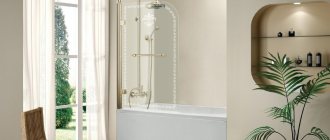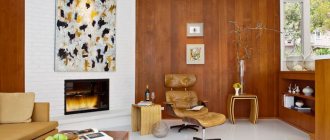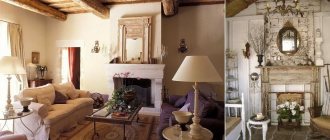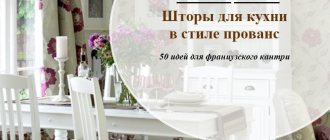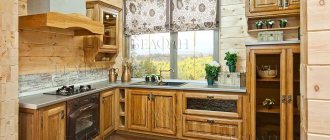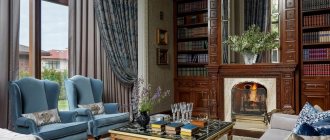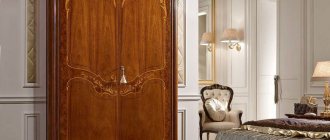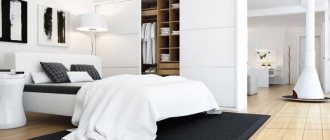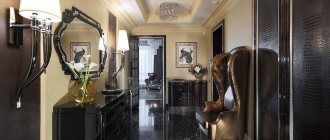The use of glass blocks as decor for practical and aesthetic designs in interior design is becoming increasingly popular today.
Decor in the bedroom interior Source remoo.ru
The material is used for the construction and decoration of walls of residential and industrial premises.
Colored glass blocks in the hallway Source www.rmnt.ru
Blue glass block Source photointeriorpro.ru/
Glass blocks in the bedroom interior Source remontbp.com
What is glass block?
A traditional glass block was a hollow cube with walls made of glass about one centimeter thick, which, due to the internal air cushion, reduced sound transmission by 60–70%, light transmission was 80%, and dense glass blurred the outlines of people behind it and prevented anyone from watching. which was not intended for prying eyes.
In addition, they were very durable, so glass walls made of cubes did not frighten either mothers in kindergartens or residents of Brezhnevkas, whose entrances were regularly decorated with blue-green glass delights.
But as the wise Ovid said: “Tempora mutantur, et nos mutamur in illis” (translation: Times change, and we change with them), so the glass blocks have changed, acquiring new forms - for example, bricks; new content - they are filled with installations, herbariums or mother of pearl; a new type is decoration with ornaments or graphics, as well as painting glass in different colors.
The sizes of glass blocks in apartment interiors vary greatly, but the most popular are standard cubes 24x24x8 and 19x19x8.
Useful qualities of glass blocks
They are a block that consists of glass plates welded together with a thickness of at least 100 mm. There are different types and sizes of glass blocks. They most often represent an equilateral square, but they also come in triangular and round shapes. Standard sizes are 19x19 and 24x24 cm. The weight of an individual block ranges from 2 to 4 kg.
Physical properties:
- Transparency;
- Sound and heat insulation;
- Non-flammability;
- Strength;
Glass does not react with the external environment, due to this, oxide films do not form on it, and it is easy to clean.
Types and features of material
So, what kind of finishing material is this and what do glass blocks generally look like in the interior? To put it simply, it is a kind of hollow inside “sandwich” made of two thick centimeter glasses combined with each other. In the Soviet Union they were produced according to standards that have smoothly migrated to the present day.
There are only two size ranges: 19x19x8 and the second - larger - 24x24x8.
The indicators remained the same:
- “filling” of air makes it possible to get rid of external noise in the room by almost 70%;
- they perfectly transmit light, leaving what is happening inside the house closed from prying eyes;
- In terms of strength, this tile can be compared to a brick; it conducts heat better than its counterpart, but one piece weighs significantly more than a brick - up to four kilograms.
What has undergone significant changes today is the appearance of tiles. Only the lazy cannot find a design and shape to suit their taste on the market today: with a pattern and in plain colors, with and without backlighting, in the form of stained glass or installations, decorated with flowers, corals and whatever your heart desires. Choose and conquer.
The form has also undergone significant changes. Today you can find not only classic rectangles and squares, but also triangular and even round options.
Advantages and disadvantages of finishing material
pros
Taking into account its characteristics, glass can be harmoniously integrated into almost any room.
- Durability - a wall made of glass blocks will look good in the interior and is guaranteed to serve you for many years.
- Moisture resistance is why glass blocks are very popular in bathrooms.
- Easy to clean. A special glass cleaner, a rag and five minutes of time is all you need.
- Noise insulation. The sound of water, screams on the street or loud music - you can forget about these irritating factors.
- Thermal conductivity. Glass blocks also work well with the air temperature in the room: by maintaining the required level of heat, they make your home even more comfortable.
- Light transmission. The thickness of one layer of glass is more than a centimeter, but this does not prevent almost all sunlight from outside from entering the house - up to 90%.
Minuses
Almost an ideal finishing option, isn't it? But what's the catch? It is usually clarified at the installation stage.
The thing is that to build a structure, you simply need professional skills. And if you don’t have them, be prepared to spend money on a specialist, otherwise you risk failing the entire aesthetic component of the issue.
- Weight. As already mentioned, it is about 4 kilograms per square. This not only complicates the construction process, but also is a significant burden in the overall engineering plan of the premises. To put it simply, if you don’t want to fall into the hands of your neighbors below, you shouldn’t decorate a surface larger than 15 square meters in this way.
- If you are a fan of decorating your walls with paintings or photos, this item is for you. The fact is that you cannot screw screws or drive nails into a glass wall. Hanging a shelf, decorating with a picture or attaching hooks - all this is not about glass blocks.
- The material must not be cut. This means that you will have to fully accept the conditions dictated by the size of the source.
- It is impossible to install wiring in such a wall.
- The design does not allow air to circulate. That is why you should not decorate window openings with them - the apartment will not breathe.
Advantages of interior design
Glass blocks have a lot of advantages, among the advantages of the material they note:
- Fire safety and frost resistance.
- High light transmittance.
- Super strength.
- High sound insulation characteristics.
- Easy to maintain and no need for additional finishing.
Unfortunately, glass blocks also have a number of not so significant disadvantages. You cannot drive a nail or drill a hole into such a “wall.” It will not be possible to cut the fragments during installation, and in cases where the window is made only of glass blocks, it is impossible to ventilate the room without using a door. The material cannot withstand high pressure.
Glass block walls can participate in zoning rooms deprived of light. This material is also popular for finishing home greenhouses and winter gardens, as it provides a favorable environment for growing plants.
In the living room
Glass blocks in the living room interior can be used to create full-fledged partitions.
The use of glass elements in wall decor looks very interesting, stylish and unusual.
The material is used to construct the base of a small coffee table or a full-fledged dining table.
By decorating the walls with glass blocks, you can highlight the necessary area in the room.
In the bedroom
Glass blocks in the bedroom interior create a calming and relaxing atmosphere due to their ability to diffuse and refract light.
A glass block partition will help create a cozy atmosphere in the sleeping area.
Glass blocks can be used to decorate a doorway or part of a wall.
A wall made of blocks located opposite the window will create a festive atmosphere in the room, especially if you choose colored glass blocks, such as green ones, for decoration.
In the hall
In most cases, hallways have a small area; to visually enlarge the space, you can use light shades in the interior or decorate the corridor with glass blocks.
The door to the living room can be replaced with a beautiful arch made of glass blocks.
The floor and ceiling can also be finished with a strong material, such as blue. You can make a small table from glass blocks near the wall.
Adding glass blocks to your wall trim can help improve illumination in a poorly lit hallway.
In the kitchen
Glass blocks are used more often in creating kitchen interiors. Glass material is used not only for finishing walls, window and door openings, but also for finishing a kitchen apron, decorating and zoning a room.
Recently, glass blocks have been used to make table bases. This decor looks quite interesting and unusual.
Clear glass blocks pair well with white kitchen cabinetry or wood trim.
Original solutions in a modern interior
The material is universal. It needs to be looked at from a creative point of view, that is, perceived as a set of “bricks” that, like Tetris, can be laid out in different ways. Not only partitions or inserts are made from glass blocks. This unique material will allow you to create a chic bar counter in the kitchen or living room. It can be colored or imitate a “block of ice” if the element of colorless fragments is provided with the correct lighting. Glass blocks are also used to decorate stairs instead of traditional balusters with railings.
Not only the walls are made from the material, but also the floor, and sometimes even part of the ceiling. In the second case, the area will have natural light, but in the first, it is better to install a special lighting system. Translucent flooring will add perspective to a room with low ceilings. Tables are made from glass blocks with original filling, where “legs” are made from the material, and the table top is fixed on top. The pieces can be stacked like bricks to create stunning open shelving with stylish glass shelves between the support columns.
Specifications
According to the technological features of the technical processing of glass, glass blocks can be matte, embossed, even and smooth, glossy, colored, colorless, decorated. These indicators influence the light-scattering effect and determine the light-directing component.
Colorless variations have a transparency rate of 70-90%, colored - 50-70%, matte - up to 50%.
The material can have a colorless transparent base or a decorative one. It all depends on the design idea and area of application. And you can choose any color scheme and artistic palette!
Glass LED blocks and illuminated “bricks” are in fashion. Illuminated decorative elements in the voids have a semblance of a 3D effect.
How to use glass blocks in home design
Walls and partitions are the most common type of application of the building and finishing material that has become universal. For this purpose, it is extremely durable, soundproof and moisture resistant.
Translucent architectural structures look the most successful and are practical in the interior of a dining room, bathroom, or toilet.
Partitions allow you to zone the studio space, while walls allow you to delimit semantic zones. For example, separate the bathtub from the toilet. Uniqueness and originality are achieved by using blocks of various colors and configurations in the design.
In the kitchen, glass blocks look attractive in the decoration of a bar or island area in the form of stylized partitions.
Shower cabins are often made using semicircular partitions. Glass blocks do not let drops of water through and do an excellent job of increasing illumination: the penetration of natural light and creating an intimate environment, closed from prying eyes. Installations inside blocks of decorative elements “under the aquatic environment”, additional lighting will make the structures “alive” and original.
Glass block windows are most often installed in technical rooms. These include, with a reservation, utilitarian rooms - a bathroom and a toilet. Instead of a “blank wall”, a translucent window made of blocks in a private house is not only a bold, but also a practical, original solution. No additional curtains or blinds are required here.
At the same time, the sizes and configurations of window openings can be of the most intricate shapes, different geometries and locations on the wall.
“Unexpected” solutions in the use of glass blocks in the interior:
- semicircular island counter with lighting, serving as a bar area and serving area for the dining room;
- fragmentary wall inserts made in a “chaotic” but thoughtful design manner;
- the floor and roof of a private house made of durable glass block will make an office, greenhouse, winter garden, attic unique;
- table made of glass blocks on a rigid frame for the strength of the entire structure.
Where are glass blocks used?
Glass blocks are distinguished by good sound-proofing and heat-saving properties, increased resistance to moisture and other external factors.
Application of material:
- For wall decoration or decorative inserts.
- To create partitions by dividing the room into functional zones.
- For finishing external walls of residential premises.
- For zoning the bathroom, finishing the walls of shower corners.
The variety of surfaces, shapes and colors of glass blocks allows this material to be used for interior decoration in different stylistic directions.
Most often, glass blocks are used to decorate the bathroom. The material is practical, resistant to high humidity, easy to maintain, more reliable and durable than drywall. Glass block walls are suitable for decorating a shower stall.
In combined bathrooms, the material can be used to divide a spacious room into functional zones. A straight or round wall made of multi-colored or plain glass blocks can be used to decorate a shower stall or staircase.
You can also create a small partition between the bathroom and the bathroom. In a large room, the washing machine can be separated from the main compartment, creating a small room for washing and storing clothes.
In the bathroom of a country house, you can cover the window with glass blocks with colored patterns or stained glass; when exposed to sunlight, the window looks interesting and unusual. Partitions and walls made of glass blocks are very strong, but they cannot replace load-bearing walls.
Rules for decorating a room with glass blocks
- This material is “contraindicated” to classic styles: classicism, renaissance, baroque, gothic, empire. It is not always appropriate for rural areas: Provence, country, when wood is used in construction and decoration.
- In the design and architectural community, it is generally accepted that the most harmonious ratio of glass blocks to other finishing components of a separate living space is 1 to 10. At the same time, the toilet and bathtub do not have such restrictive recommendations.
- Glass blocks should not be the basis of load-bearing structures. They carry out exclusively decorative and design functions.
- They also successfully cope with zoning of any space, especially studio variations.
- It is advisable to “balance” the use of transparent, colorless materials in the living room with bright notes of color in order to completely avoid the “office” impression.
- Glass combines harmoniously with metal, wood, parquet, laminate, carpets, fabric bases and wallpaper.
Laying blocks
There are 3 ways to install glass blocks:
- Without a solution, instead they turn to frames or modules made of wood.
- Using a mortar of cement and sand.
- Using glue.
The first method is suitable even for beginners who are not familiar with laying any types of bricks. The module includes cells where you need to install blocks, securing them with rubber gaskets.
This method allows you to make a flat wall in a short period of time, without resorting to a level. Another advantage of this installation method: ease of dismantling. If necessary, the partition can be disassembled without damaging the glass blocks. This cannot be achieved if installed with adhesive or mortar.
Adhesive for installing cubes is sold complete with blocks. This type of installation is also very fast. The glue has a transparent structure, so it does not spoil the appearance of the finished wall.
It is much more difficult to make glass masonry using mortar. This method is the cheapest and most common for many craftsmen.
There are a number of recommendations for using cement-sand mixture:
- You need to choose very fine sand, as large pebbles can scratch the glass;
- You can lay out a maximum of three rows per day: the setting of the solution and glass occurs slowly;
- The mortar is not suitable for the construction of high walls, since the lower layers may crack under the weight of the upper ones;
- To create a durable structure, before laying each subsequent row, it is necessary to insert metal rods with a cross-section of 5-6 millimeters into the seams;
- The seams need to be treated with colored grout, as stripes of gray cement will spoil the appearance. To save time, you can immediately buy cement with pigment.
Limitless design possibilities
Most often you can find glass blocks in the bathroom or kitchen. In the interior of a children's room, bedroom or living room, they are used less often, more as a decoration than a functional element.
The main features of glass blocks that attract designers:
- Decorative glass blocks are capable of transmitting more than 80% of sunlight, while at the same time allowing you to create a barrier behind which you can comfortably retire. This is true for small rooms;
- Glass and plastic blocks are particularly resistant to moisture. These qualities will be useful in residential apartments and houses (bathroom, kitchen, dining room), as well as in public places (dining rooms, saunas, beauty salons, swimming pools);
- The structures are very durable and comfortable to use;
- Glass blocks in the interior of a bathroom or kitchen look organic and fit well with any design and other materials in the apartment;
- A shower cabin made of glass blocks, glass partitions, compositions in door or window openings are very durable, they are convenient and easy to care for;
- Excellent sound insulation (for example, glass blocks will muffle the sound of pouring water by 60-80%);
- Good thermal insulation properties.
Glass block walls
Today, many owners of small apartments prefer to remove walls and partitions that are not load-bearing, and create interior structures of a more modern and convenient format.
Walls made of glass blocks allow you to perfectly zone the space and effectively complement the modern design of any apartment.
Interior walls made of transparent blocks are an ideal solution for landscaping dark halls, corridors, lobbies, where a lot of sunlight will enter through a glass prism, but the effect of seclusion and separation of one room from another will remain.
The use of glass blocks in large quantities is associated with some aesthetic difficulties.
The design may seem too cold, “soulless”. “Ice cubes” in the interior of the apartment must be supplemented with other materials with a warmer, more comfortable texture.
Partitions made of glass blocks
In modern interior design of apartments and houses, it is customary to form partitions of non-standard shape:
- Pyramid;
- Trapezoid;
- Ziggurat;
- steps;
- Arch;
- Oval;
- Round designs with holes.
A shower cabin made of glass blocks or a partition in the bathroom made of such decorative elements perfectly follows the rhythm of the tiles on the walls and emphasizes the cold aesthetics. Glass is not afraid of moisture, temperature changes, and diffuses light well.
You can “insulate” the sterility of glass partitions using decorative installations inside the blocks.
In a modern bathroom design, you can use shells and other “water” motifs. For the kitchen, gastronomic ornaments and compositions are more relevant. For example, fill the voids of transparent glass blocks with coffee beans or dummies of fruit.
Formation of window openings
Often, interior windows in apartments and houses are formed using spectacular glass blocks. They give lightness and airiness to the walls and allow better dispersion of the sun's rays.
Particularly noteworthy are the illuminated designs, which look great in the design of living rooms, bedrooms and hallways.
Installation of glass block partitions
Creating structures from glass blocks is a simple process. Installation of glass block partitions includes the following steps:
- Determining the installation location of the partition.
- Preparing and cleaning the mounting surface. Using slats, you need to outline the boundaries of the base of the structure.
- Laying the first row of glass blocks.
- Installation of stainless steel reinforcing rod. It is not recommended to lay more than 3 rows of blocks per day, as the structure may warp.
- After the mixture has completely dried, you need to remove the crosses and protective film on the blocks and begin applying the grout mixture.
- After cleaning the partition and drying it completely, it is necessary to protect the structure from moisture by applying a waterproofing liquid.
Laying glass blocks
- There are two main types of installation of glass blocks: the use of plastic or wooden modules and laying the material on cement mortar. Using the first option, you can fold the wall like a construction set, inserting glass blocks into all or only the required cells.
- When using the second mounting method, you need to take into account that the seam will be filled with a special product (dye), which means that the cells must be completely empty. This type of masonry is very reminiscent of brick.
- It is also necessary to remember that glass blocks do not absorb moisture, and the wall takes a long time to dry. Therefore, the structure must be laid gradually, 2–4 times a day, and the actual commissioning of the wall should be carried out no earlier than after 7–8 days.
Do-it-yourself technology and methods of installation
There are several ways to attach glass blocks. Choose the appropriate option based on the size of the partition itself. It should be understood that the elements cannot be cut, so before purchasing materials you need to study the products of different manufacturers. For decorative blocks with a pattern, you will first need to make a pattern, according to which you will later arrange all the elements on the floor.
Frame
The method is suitable for creating light and small structures. Most often these are half partitions for zoning. The strength indicators and soundproofing qualities of the structure in this case will be much lower than when assembled using other technologies.
The main advantage of assembling glass block frames is aesthetics. Another advantage is the ability to replace elements and clean operation. A wooden frame is used as a base. The design of the cell resembles a lattice or shelving in size of the glass parts.
First of all, the frame is attached to the base. It is screwed to the floor, to the wall with dowels or anchors. Special rubber gaskets are placed on the glass blocks, which are inserted into the cells of the frame or staircase. To add strength to large structures, sealant is used.
If you need to give a wooden structure a certain color, you need to paint it in advance.
For solution
Cement is used as an adhesive mixture. It should be uniform, without large grains of sand that can scratch the glass. You will also need to purchase crosses to establish a fixed distance between the blocks and add rigidity. Reinforce the glass wall with metal rods.
After laying a series of glass elements, a new layer of concrete is applied and the metal rod is laid horizontally. If the structure area is large, then additional metal supports are installed vertically. It is recommended to install no more than three rows of glass blocks at a time. To prevent the structure from falling apart, the cement mixture must be allowed to dry for at least a day.
On glue
A wooden frame is used as a base. It is cleaned of debris, dust and the main marks are applied. To determine the required distance on the panel, arrange the blocks and plastic dividers. Then the length and height of the future structure are measured, and the dimensions of the frame are calculated. If in the future it will be attached to the wall structure, holes must be drilled in certain places.
To install transparent elements, white tile adhesive is used. This way the seams will be more aesthetically pleasing, and the likelihood of the part being stained is minimal. First, they check the integrity of the glass blocks, because manufacturers guarantee the quality of the elements only until the moment of their installation. They are then laid in rows, placing reinforcement to support the strength of the structure.
It is not recommended to remove the protective film from glass blocks during installation. This will help protect them from damage. If it is not there, you should stick polyethylene on it, securing it with paper tape.
Glass blocks in design: how to combine correctly
First of all, it is worth immediately separating the concepts of “glass wall” and “classic style”. Classicism does not tolerate such tricks and, as a result, glass blocks cannot be used in interiors decorated in the spirit of Baroque, Renaissance, Empire style - in any classic style. Doesn't always go well with country and Provence.
If you do not have professional knowledge, it is better not to take risks, so as not to end up in bad taste.
This is where such designs fit perfectly - these are high-tech, modern, modern and, under certain circumstances, minimalism styles. Beautifully transparent cubes will complement the loft space, highlighting and highlighting its brutality.
Stylistic compatibility
Transparent blocks will fit into literally any interior style.
They look best in styles:
- urban, hi-tech;
- neo-baroque, neo-classical spaces;
- modern, loft;
- art deco, art nouveau;
- stylizations in oriental style.
Classical, baroque and rococo interiors, in which a historical bias is noticeable, are not suitable for the use of transparent cubes. Glass will also look out of place in “home” interiors in Provence, country, or rustic styles.
General tips for using glass blocks in the interior of an apartment
- To prevent your living room from turning into an office, add some color to the interior.
- When decorating the space in blocks, add metal, wooden parts or textiles - for example, a carpet will look very cozy.
- It is ideal to use glass blocks in the bathroom interior. You can even make an entire shower partition out of them. See for yourself: this finishing material perfectly waterproofs, does not darken the space, and “removes” the sound of water. And if you add colored parts, lighting and marine decor inside the block, it will turn out just great.
- Pros believe that the total amount of glass tiles to all other materials should be approximately 1 to 10. Stick to this rule - redundancy has never benefited anyone.
- Do not under any circumstances replace load-bearing walls in the house with them and do not include individual squares in such structures. Glass in the interior is exclusively about decor and beauty.
- Do you need to delimit several active zones in one room? A translucent wall is ideal for this.
